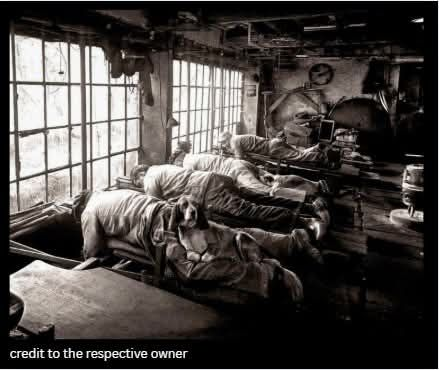In the early 20th century, deep in the industrial heart of France, there existed workplaces so grueling and unusual that they’ve almost faded from public memory: the grinding rooms. These dim, dust-filled workshops were where men performed painstaking labor that required them to spend their working hours not standing tall or even seated, but lying flat on their stomachs.
The job was as physically demanding as it was monotonous. Workers would lie belly-down on wooden planks, their torsos pressed into the boards, and extend their arms to maneuver heavy slabs of glass across grinding stones. The motion was repetitive, exhausting, and unrelenting—each pass of the glass wearing away imperfections, smoothing its surface, and preparing it for further refinement.
The Toll on the Body
This peculiar posture was not chosen for comfort, but for necessity. By lying flat, workers could better control the pressure and precision required to smooth delicate glass. Yet, the price of this method was extraordinary strain on their bodies. Hours spent face-down meant chests were compressed, breathing was restricted, and muscles were continuously stressed. Workers often complained of aching ribs, stiff joints, and shortness of breath.

The air itself was another silent killer. Fine glass dust filled the grinding rooms, clinging to clothes, hair, and skin. Every breath pulled particles into their lungs, often leading to chronic respiratory illnesses. Protective gear was virtually nonexistent, and little concern was given to long-term health effects. In those days, survival was tied directly to earning a wage, and safety was a luxury.
The Life of the Grinder
To endure such conditions required resilience. Men would begin their day before dawn, spending long hours in darkened rooms illuminated by the faint glow of oil lamps or streaks of daylight breaking through windows coated in dust. Conversations were sparse—partly due to the noise, but also because each man was locked into his own rhythm, focused on the relentless task at hand.
Breaks were few, and the wages were modest. Yet, grinding was considered a respectable trade. It was an essential part of the glassmaking process, a craft that allowed artisans and manufacturers to produce mirrors, lenses, and decorative pieces that adorned homes across Europe. For many families, the work of these grinders provided a steady, if difficult, livelihood.
A Forgotten Chapter of Labor History
Today, the image of a man lying face-down in a dim room to grind glass seems almost unimaginable. Modern machinery has replaced the painstaking manual labor of the past, rendering the grinding rooms obsolete. Yet, their story is an important reminder of the human cost behind everyday objects that are often taken for granted.
These workers, largely anonymous in history, endured exhausting conditions to bring refinement and clarity to glass. They sacrificed health and comfort in pursuit of perfection—an invisible legacy that continues to live on in the beauty of glasswork still admired today.
The grinding rooms of early 1900s France may be forgotten by most, but the memory of those who toiled within them lingers as a haunting reminder of the resilience—and suffering—woven into the history of labor.